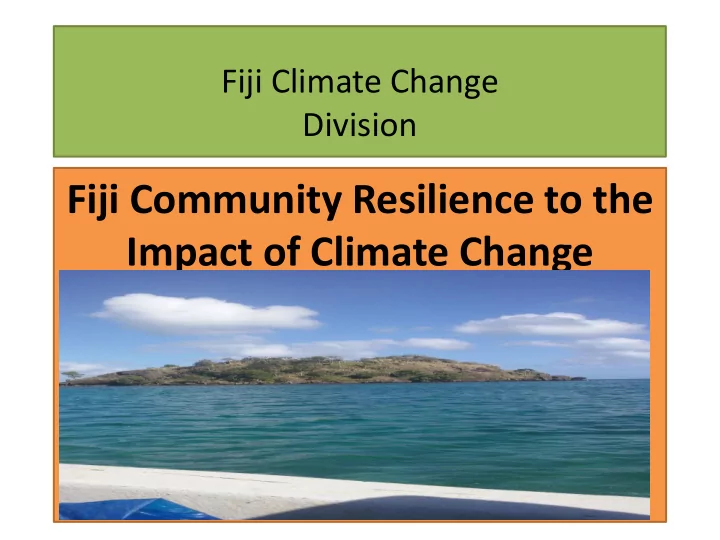

Fiji Climate Change Division Fiji Community Resilience to the Impact of Climate Change
Presentation Outline • Linkages – National Climate Change Policy & Green Growth Framework • Way Forward for Fiji • What is an IVA • Brief Summary – IVA Framework • Purpose of IVA • Project Outcomes • Targeted Output • Success • Challenges • Lesson Learnt
ASSESSMENT, MAPPING & DIGITIZATION OF VULNERABILITY
Climate Change Policy Relevance Objective 2: Data Collection, Storage & Sharing Objective 5: ADAPTATION Strategy 2: Calls for inclusion of Vulnerability assessments & climate change impact projections into resource management planning. Strategy 5: Support the ecosystem- based approach throughout Fiji, recognising that ecosystem services, such as food security, natural hazard mitigation and physical coastal buffer zones, increase resilience.
Fiji National Strategic Planning & Development GREEN GROWTH FRAMEWORK. Thematic Area 1. Building Resilience to Climate Change & Disaster. A Key Challenge A need to develop an integrated approach & policy & operational level to effectively address climate change & disaster management .
Way Forward For Fiji 1. Review V&A tool [Consultations] (August - October) 2. Develop a framework (August- October)-Partners: USP & SPC. 3. Inception workshop of sector experts to consolidate the proposed Integrated Vulnerability Assessment (IVA) framework and method of assessment. �O�to�er �15�. 4. The IVA framework incorporate principles and elements of CCA (CCA), disaster risk reduction (DRR), loss & damage (L&D) and sustainable development 5. Piloted in the Province of Macuata - 20 th /10/15.
What is an IVA? A vulnerability assessment is an approach that integrates: • Climate Change Adaptation and Disaster Risk Management • Addresses the underlying barriers to achieving sustainable development • Multi-sectoral focus: Human security. 1.Forest & Marine Protection 2. Security of place 3. Income security 4. Water Security 5. Food Security 6. Energy security 7. Health security
Livelihood Assets 1. Infrastructure & technology 2. Natural Resources and Ecosystems 3. Human Resources 4. Institution and governance 5. Finance
The two key parts of the proposed IVA framework 1. The vulnerability context: – Experienced and projected demographic and development (resource use) changes – Overlayed with experienced and anticipated changes in climate – Community location and general profile (overview) 2. The assessment of community adaptability or resilience
Defining community resilience • The ability of local communities to utilise the resources available to them to meet their livelihood needs in changing environment. • Community resilience is determined by a combination of inter-dependent factors that from which livelihood needs are met. • Previous VAs often refer to community access to �livelihoods assets� as the foundational fa�tors determining community resilience .
Purpose of the IVA 1. Important to assess community resilience or adaptive capacity and combining assessment of basic human security. 2. Fijian men, women and children are more resilient to climate change impacts through better informed decision making and planning processes 3. It will support decision making on relocation & reduction of loss & damage. 4. Reports on the vulnerability of our communities to the international communities 5. Contributes to the national reports for the Sustainable Development Goal, UNFCCC & Sendai Framework
Project outcomes • Increased understanding of the degree of vulnerability of Fijian communities; • More inclusive process for community consultation and data gathering on climate change risk • Improved efficiency in the identification of appropriate and cost effective adaptation interventions for vulnerable communities; • Improved climate change adaptation baseline data and policy advise
• The project will directly benefit multiple sectors of government, non-government organizations and the local communities. • The project will engage the community through a participatory approach that encourages women, youth, people with disabilities and marginalised group participation.
Targeted outputs • IVA reports for each of the 4 Divisions, 14 provinces and all districts – 3years- 2015- 2018 • Database storing vulnerability scores for all community assessments • Digitised map of vulnerable communities
Project Sites The IVA will be carried out in all communities in the 4 major Divisions with 15 Provinces across Fiji.
Assessment Team in the Northern Division
Success • Involvement and support of stakeholders, government ministries, non-governmental organisations, Civil Society Organisation, provincial council, communities and resource owner. • Translation of the tool in iTaukei language, later to Hindi. • Pilot the tool in Macuata Province assist the Training of the IVA at the divisional level. (Savusavu). • Developing either a standalone unit of competency or skill set which in turn would incorporated into a qualification in climate change adaptation. (PacTVET)
Challenges 1. Accessibility: Geographical make up of the country 2. Expensive exercise: need more funding 3. Availability of key informants at the community level. 4. Management and storage of Data 5. Meeting timeline due to climatic conditions.
Lesson Learnt • Field Assistance to be well trained with good understanding of climate change and natural disaster issues • Focus Group discussions • Use of Divisional and Extension Officers to assist in the Assessment • Identify community resource people to assist in the Assessment • Gender Balance • Good community interactions
Thank You for Listening
Recommend
More recommend